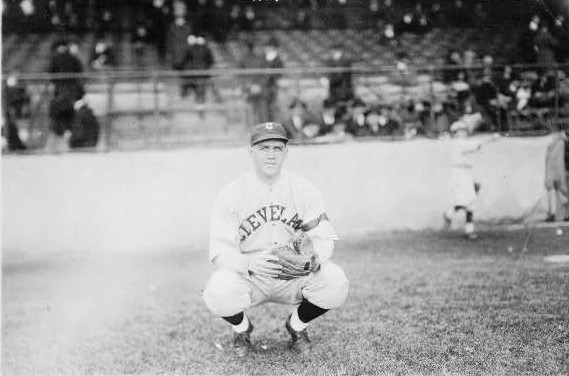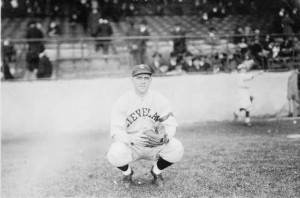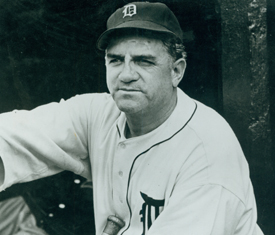Historical Hitter October 12th 1920: Steve O’Neill

Today was the day the Indians won their first World Series, in fact the Indians won their first world series before the Yankees won their first. The Indians beat the Dodgers in a best of nine series 5 games to 2. Yet it is a World Series remembered more for three individual plays, a crime, and the series played in memory of Ray Chapman.
 There was no official World Series MVP award at the time, so my award for MVP goes to catcher Steve O’Neill. His consistent play at the plate and behind the plate guided the Indians to the Promised Land. He played in all the games. His signature defensive play was blocking the plate in keeping Brooklyn’s Ed Konetchy from becoming the tying run. He called great games behind the plate keeping Dodger hitters off balance. The Dodgers scored only one run in their last 27 innings. He batted an even .333 going 7 for 21, with 3 doubles and 2 RBI and four walks. His two doubles in Game One helped seal the Cleveland victory. His play during the 1920 Fall Classic inspired sportswriters to label him the “King of Maskmen.”
There was no official World Series MVP award at the time, so my award for MVP goes to catcher Steve O’Neill. His consistent play at the plate and behind the plate guided the Indians to the Promised Land. He played in all the games. His signature defensive play was blocking the plate in keeping Brooklyn’s Ed Konetchy from becoming the tying run. He called great games behind the plate keeping Dodger hitters off balance. The Dodgers scored only one run in their last 27 innings. He batted an even .333 going 7 for 21, with 3 doubles and 2 RBI and four walks. His two doubles in Game One helped seal the Cleveland victory. His play during the 1920 Fall Classic inspired sportswriters to label him the “King of Maskmen.”
Game 5 was the scene for this Series’ most famous firsts. The Tribe took charge in the bottom of the first with the first grand slam in World Series play by Elmer Smith. In the home fourth, Cleveland Pitcher and Hall of Famer Stan Coveleski hit a three run homer, the first home run by a pitcher. In the top of the fifth with two runners on, a line drive off the bat of Clarence Mitchell caught by Bill Wambsganss resulted in the first and only unassisted triple play in the World Series.
Before Game 5, in one of the more infamous World Series incidents, Brooklyn Pitcher and Hall of Famer Rube Marquard was arrested by the Cleveland Police for scalping tickets, and thus scratched as the starter. He was found guilty on October 12.
Initially O’Neil was the prototype all-defense catcher and in 1917 owns one of the lowest full season averages; a very anemic .184 (68 for 370) for a 47 OPS+ in 129 games. With the arrival of Tris Speaker as player- manager of the Indians, O’Neil was taught how to hit. Three seasons later in 1920 he hit .321 (157 for 489) and 121 OPS+. And for three years, 1920-1922, he hit over .300. That is an increase of 137 points in the average, and 74 OPS+. The three hitting dictums from Speaker were:
“..in the first place go up there figuring you’ll get a hit, not that you won’t.
In the second, try to outthink the pitcher.
And in the third, stop swinging at bad pitches.”
He was known as the best catcher of the dead ball era, noted for throwing out runners attempting to steal, blocking the plate, calling for curve balls with the tying or winning run at third, and being unintimidated by other players. He was one of the few players that Ty Cobb and his spikes could not awe.
 O’Neil, like many catchers, was a long time baseball coach and manager. He was the Tigers skipper that won the 1945 World Series, billy goat withstanding. He is credited as mentoring Bob Feller from a teenage thrower into a Hall of Fame pitcher. His 14 seasons as a big league manager left him with a very respectable win-loss total of 1040-821and a winning percentage of .559 which is tenth on the list. As a testament to his leadership and mentoring, all his seasons managing have a winning record. His formal baseball career lasted from 1910 to 1954. He then returned to Cleveland as a special assistant to Hank Greenberg and running youth baseball clinics until he died in 1962. In 2010, he was shortlisted by the Veterans committee of the Hall of Fame for the managers/umpires category.
O’Neil, like many catchers, was a long time baseball coach and manager. He was the Tigers skipper that won the 1945 World Series, billy goat withstanding. He is credited as mentoring Bob Feller from a teenage thrower into a Hall of Fame pitcher. His 14 seasons as a big league manager left him with a very respectable win-loss total of 1040-821and a winning percentage of .559 which is tenth on the list. As a testament to his leadership and mentoring, all his seasons managing have a winning record. His formal baseball career lasted from 1910 to 1954. He then returned to Cleveland as a special assistant to Hank Greenberg and running youth baseball clinics until he died in 1962. In 2010, he was shortlisted by the Veterans committee of the Hall of Fame for the managers/umpires category.
[divider]
Sources:
Baseball Hall of Fame, http://community.baseballhall.org/page.aspx?pid=448
SABR BioProject by Adam Ulrey, http://sabr.org/bioproj/person/ef6e78f2
Baseball-almanac.com
Baseball-reference.com
